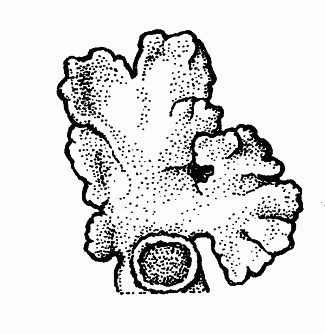Pannaria rubiginosa (Ach.) Bory
Considerable gingerbread
Pannariaceae
Introduction to the Lichens
Considerable gingerbread
Pannariaceae
Introduction to the Lichens
Map
Distribution of Pannaria rubiginosa unavailable
Species Information
General:
Common Name: The Mouse Lichens. Reflects the miniature size of the lobes and the dull greyish brown colour of the upper surface in many species. Minute to small or occasionally medium stratified squamulose, foliose or occasionally crustose lichens, corticate above, noncorticate below, sorediate or (apparently) isidiate or not, rarely pruinose, lobes closely appressed, subrotund to elongate, averaging to 1–3 (–4) mm wide, thin to thick. Upper surface pale tan to greyish blue or dark brownish (lobe margins often whiter), smooth to slightly roughened. Lower surface pale and often resting on dark hypothallus. Medulla white. Photobiont blue-green.
Apothecia located over upper surface, disc usually reddish brown; spores simple, ellipsoid to somewhat spindleshaped, colourless, 8 per ascus.
Over bark, rock, moss and soil.
Notes: Pannaria is primarily a temperate genus of approximately 80 species worldwide. Of the 17 species reported for North America, seven are known to occur in B.C., while several other possibly undescribed species also occur. The accounts are therefore preliminary, pending further study of the western species.
Species description:
Photobiont a dark (greenish) blue to dark greyish blue cyanobacterium AND
Thallus lacking true soredia (Note: Soredia-like “isidia” may sometimes be present, but these never originate on undersides of lobes) AND
Thallus lacking isidia (Note: Some species may produce flattened, isidia-like lobules, though these usually lie in same plane as lobes) AND
Over bark or wood (or over moss on bark or wood); coastal AND
Upper surface somewhat roughened/scabrid, especially toward lobe margins; marginal lobes usually radiating, flattened to concave, usually broader than central lobes; apothecial rim thalline (i.e., coloured alike with upper surface of lobes),“warty,” often covered below in minute white hairs AND
Marginal lobes usually averaging to more than 1.5 mm wide; medulla PD+ orange or yellow (rarely PD-)
Comments:
PD- strains of P. rubiginosa lack chemical substances altogether. The similar P. leucostictoides, though also PD-, contains atranorin and various fatty acids and terpenoids.
Reactions:
Medulla PD+ orange or yellow, or rarely PD-; hymenium I+ persistently strong blue.
Contents:
(Pannarin.)
Source: Lichens of British Columbia
Illustration

If more than one illustration is available for a species (e.g., separate illustrations were provided for two subspecies) then links to the separate images will be provided below. Note that individual subspecies or varietal illustrations are not always available.
Illustration By: Trevor Goward
Habitat and Range
Habitat: Rare over conifers in open coastal forests at lower elevationsWorld Distribution: incompletely circumpolar, S to NM.
Source: Lichens of British Columbia